Drying of a Clayey Ceramic Flat Plate: Simulation Studies Using the Galerkin-Based Integral Method
Abstract
1. Introduction
2. Materials and Methods
- (a)
- Solids are homogeneous and isotropic.
- (b)
- The initial field of the potential inside the solid is uniform.
- (c)
- Process parameters are constant throughout the entire drying process.
- (d)
- Mass transfer occurs by liquid water diffusion (into the solid) and water evaporation (at the solid surface).
- (e)
- Heat transfer occurs by heat conduction (into the solid) and convection (at the solid surface).
3. Results and Discussions
3.1. Moisture Transport
3.2. Heat Transport
4. Conclusions
- (a)
- Both the model and the technique developed herein have great potential, presenting accuracy and efficiency in simulating many practical problems of diffusion such as heating, cooling, wetting, and drying of solids of different shapes. The solution to these different diffusion problems can be realized by changing the potential variables and the basis function related to the body’s shape.
- (b)
- The drying process at higher temperatures and lower relative humidity occurs in a shorter time. For example, at T = 110 °C and RH = 2%, the total drying time reached values close to 15,000 s and the average moisture content was almost zero. However, at T = 60 °C and RH = 14%, the total drying time reached values close to 20,000 s, and the average moisture content was almost 0.1. Thus, it is clear that at 110 °C, the drying rate is higher than at 60 °C. The same analysis can be easily verified at any moment of drying, especially at the beginning of the drying process.
- (c)
- The highest temperature and moisture gradients in the ceramic parts are found closest to the surface, especially at the edge point, making these regions more susceptible to the highest hydric and thermal stresses, which can provoke drying defects such as deformations, cracks, and fissures that reduce the material’s quality after processing.
Author Contributions
Funding
Data Availability Statement
Acknowledgments
Conflicts of Interest
References
- ANFACER—Associação Nacional dos Fabricantes de Cerâmica para Revestimentos, Louças Sanitárias e Congêneres. Available online: https://www.anfacer.org.br/setor-ceramico/numeros-do-setor (accessed on 11 August 2024). (In Portuguese).
- Callister, W.D., Jr.; Rethwisch, D.G. Fundamentals of Materials Science and Engineering: An Integrated Approach, 3rd ed.; John Wiley & Sons, Inc: Hoboken, NJ, USA, 2008. [Google Scholar]
- Silva, A.A.; Nascimento, J.J.S.; Lima, A.G.B. Analytical study of ceramic tiles drying using the Galerkin-based integral method and Dirichlet boundary condition. Rev. Eletrônica Mater. Process. UFCG 2009, 4, 48–55. (In Portuguese) [Google Scholar]
- Farias, V.S.O.; Silva, W.P.; Silva, C.M.D.P.S.; Rocha, V.P.T.; Lima, A.G.B. Drying of solids with irregular geometry: Numerical study and application using a three-dimensional model. Heat Mass Transf. 2013, 49, 695–709. [Google Scholar] [CrossRef]
- Silva, W.P.; Farias, V.S.O.; Neves, G.A.; Lima, A.G.B. Modeling of water transport in roof tiles by removal of moisture at isothermal conditions. Heat Mass Transf. 2012, 48, 809–821. [Google Scholar] [CrossRef]
- Farias, V.S.O.; Silva, W.P.; Silva, C.M.D.P.S.; Delgado, J.M.P.Q.; Farias Neto, S.R.; Lima, A.G.B. Transient diffusion in arbitrary shape porous bodies: Numerical analysis using boundary-fitted coordinates. In Numerical Analysis of Heat and Mass Transfer in Porous Media; Delgado, J.M.P.Q., Barbosa de Lima, A.G., Silva, M.V., Eds.; Springer: Berlin/Heidelberg, Germany, 2012; Volume 27, pp. 85–119. [Google Scholar]
- Araújo, M.V.; Santos, R.S.; Silva, R.M.; Nascimento, J.B.S.; Santos, W.R.G.; Lima, A.G.B. Drying of industrial hollow ceramic brick: A numerical analysis using CFD. In Defect and Diffusion Forum; Trans Tech Publications Ltd.: Bäch, Switzerland, 2019; Volume 391, pp. 48–53. [Google Scholar]
- Araújo, M.V.; Pereira, A.S.; Oliveira, J.L.; Brandão, V.A.A.; Brasileiro Filho, F.A.; Silva, R.M.; Lima, A.G.B. Industrial ceramic brick drying in oven by CFD. Materials 2019, 12, 1612. [Google Scholar] [CrossRef] [PubMed]
- Araújo, M.V.; Santos, R.S.; Silva, R.M.; Lima, A.G.B. Drying of industrial hollow ceramic brick: Analysis of the moisture content and temperature parameters. In Defect and Diffusion Forum; Trans Tech Publications Ltd.: Bäch, Switzerland, 2017; Volume 380, pp. 72–78. [Google Scholar]
- Brito, M.K.T.; Almeida, D.B.T.; Lima, A.G.L.; Rocha, L.A.; Lima, E.S.; Oliveira, V.A.B. Heat and mass transfer during drying of clay ceramic materials: A three-dimensional analytical study. Diffus. Found. 2017, 10, 93–106. [Google Scholar] [CrossRef]
- Araújo, M.V.; Delgado, J.M.P.Q.; Lima, A.G.B. On the use of CFD in thermal analysis of industrial hollow ceramic brick. Diffus. Found. 2017, 10, 70–82. [Google Scholar] [CrossRef]
- Araújo, M.V.; Sousa, A.C.; Luiz, M.R.; Cabral, A.S.; Pessoa, T.R.B.; Martins, P.C.; Silva, A.M.V.; Santos, R.S.; Oliveira, V.A.B.; Lima, A.G.B. Computational Fluid Dynamics Studies in the Drying of Industrial Clay Brick: The Effect of the Airflow Direction. Diff. Found. Mat. Appl. 2022, 30, 69–84. [Google Scholar] [CrossRef]
- Lima, A.G.B.; Silva, J.B.; Almeida, G.S.; Nascimento, J.J.S.; Tavares, F.V.S.; Silva, V.S. Clay products convective drying: Foundations, modeling and applications. In Drying and Energy Technologies; Springer: Berlin/Heidelberg, Germany, 2015; Volume 63, pp. 43–70. [Google Scholar]
- Santos, R.S.; Farias Neto, S.R.; Lima, A.G.B.; Silva Júnior, J.B.; Silva, A.M.V. Drying of ceramic bricks: Thermal and mass analysis via CFD. Diffus. Found. 2020, 25, 133–153. [Google Scholar] [CrossRef]
- Silva, J.B.; Almeida, G.S.; Lima, W.C.P.B.; Neves, G.A.; Lima, A.G.B. Heat and mass diffusion including shrinkage and hygrothermal stress during drying of holed ceramics bricks. In Defect and Diffusion Forum; Trans Tech Publications Ltd.: Bäch, Switzerland, 2011; Volume 312–315, pp. 971–976. [Google Scholar]
- Lima, A.G.B.; Delgado, J.M.P.Q.; Santos, I.B.; Santos, J.P.S.; Barbosa, E.S.; Silva, C.J. GBI Method: A powerful technique to study drying of complex shape solids. In Transport Phenomena and Drying of Solids and Particulate Materials; Delgado, J.M.P.Q., Barbosa de Lima, A.G., Eds.; Springer International Publishing: Berlin/Heidelberg, Germany, 2014; Volume 48, pp. 25–431. [Google Scholar]
- Haji-Sheikh, A.; Sparrow, E.M. Transient heat conduction in a prolate spheroidal solid Trans. J. Heat Transf. 1966, 88, 331–333. [Google Scholar] [CrossRef]
- Haji-Sheikh, A. On solution of parabolic partial differential equations using Galerkin functions. In Integral Methods in Science and Engineering; Payne, F.R., Corduneanu, C.C., Haji-Sheikh, A., Huang, T., Eds.; Hemisphere Publishing Corporation: New York, NY, USA, 1986. [Google Scholar]
- Kantorovich, L.V.; Krylov, V.I. Approximate Methods of Higher Analysis; Advanced Calculus; Wiley: New York, NY, USA, 1960. [Google Scholar]
- Beck, J.V.; Cole, K.D.; Haji-Sheikh, A.; Litkouhi, B. Heat Conduction Using Green’s Functions; Hemispheric Publishing Corporation: New York, NY, USA, 1992. [Google Scholar]
- Rosen, H.N. Recent advances in the drying of solid wood. In Advances in Drying; Mujumdar, A.S., Ed.; Hemisphere Publishing Corporation: Berlin, Germany, 1987; Volume 4. [Google Scholar]
- Abramowitz, M.; Stegun, I.A. Handbook of Mathematical Functions; Dover Publications, Inc: New York, NY, USA, 1972; pp. 752–772. [Google Scholar]
- Spiegel, M.R.; Liu, J. Guide of Formulas and Mathematical Tables. Série: Coleção Schaum, 2nd ed.; Bookman: Porto Alegre, Brazil, 2004. (In Portuguese) [Google Scholar]
- Luikov, A.V. Analytical Heat Diffusion Theory; Academic Press, Inc. Ltd.: London, UK, 1968; p. 684. [Google Scholar]
- Crank, J. The Mathematics of Diffusion, 2nd ed.; Oxford Science Publications: New York, NY, USA, 1992; p. 414. [Google Scholar]
- Itaya, Y.; Hanai, H.; Kobayashi, N.; Nakagawa, T. Drying-Induced Strain-Stress and Deformation of Thin Ceramic Plate. ChemEngineering 2020, 4, 9. [Google Scholar] [CrossRef]
- Li, R.; Zhou, Y.; Li, C.; Li, S.; Huang, Z. Recycling of industrial waste iron tailings in porous bricks with low thermal conductivity. Constr. Build. Mater. 2019, 213, 43–50. [Google Scholar] [CrossRef]
- Jiang, P.; Chen, Y.; Wang, W.; Yang, J.; Wang, H.; Li, N.; Wang, W. Flexural behavior evaluation and energy dissipation mechanisms of modified iron tailings powder incorporating cement and fibers subjected to freeze-thaw cycles. J. Clean. Prod. 2022, 351, 131527. [Google Scholar] [CrossRef]
- Jiang, P.; Wang, Z.; Li, N.; Song, X.; Chen, Y.; Wang, W. Cumulative deformation and non-coaxial characteristics of fiber and cement-modified iron tailings under the rotation of principal stress. Transp. Geotech. 2023, 43, 101114. [Google Scholar] [CrossRef]

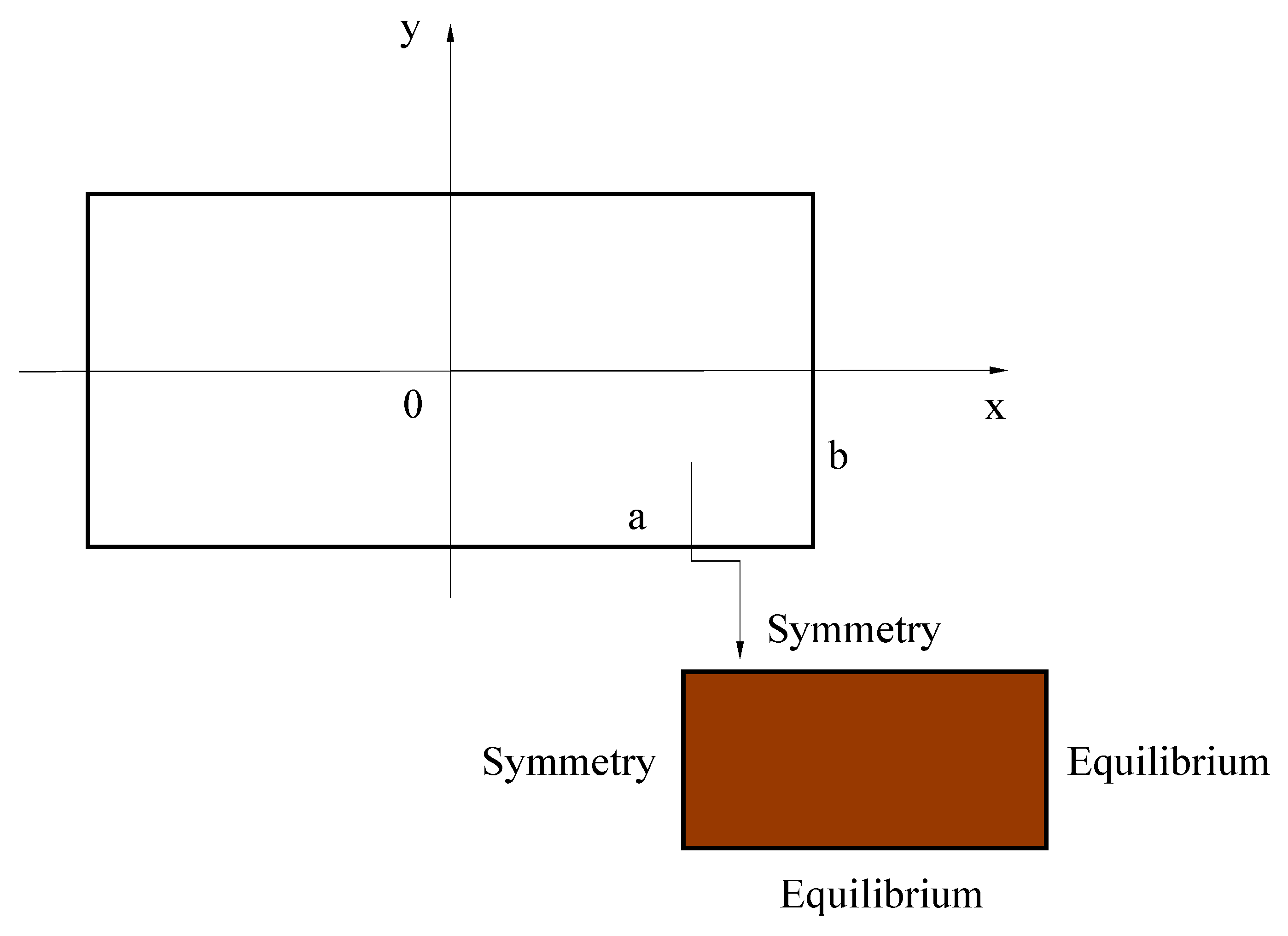

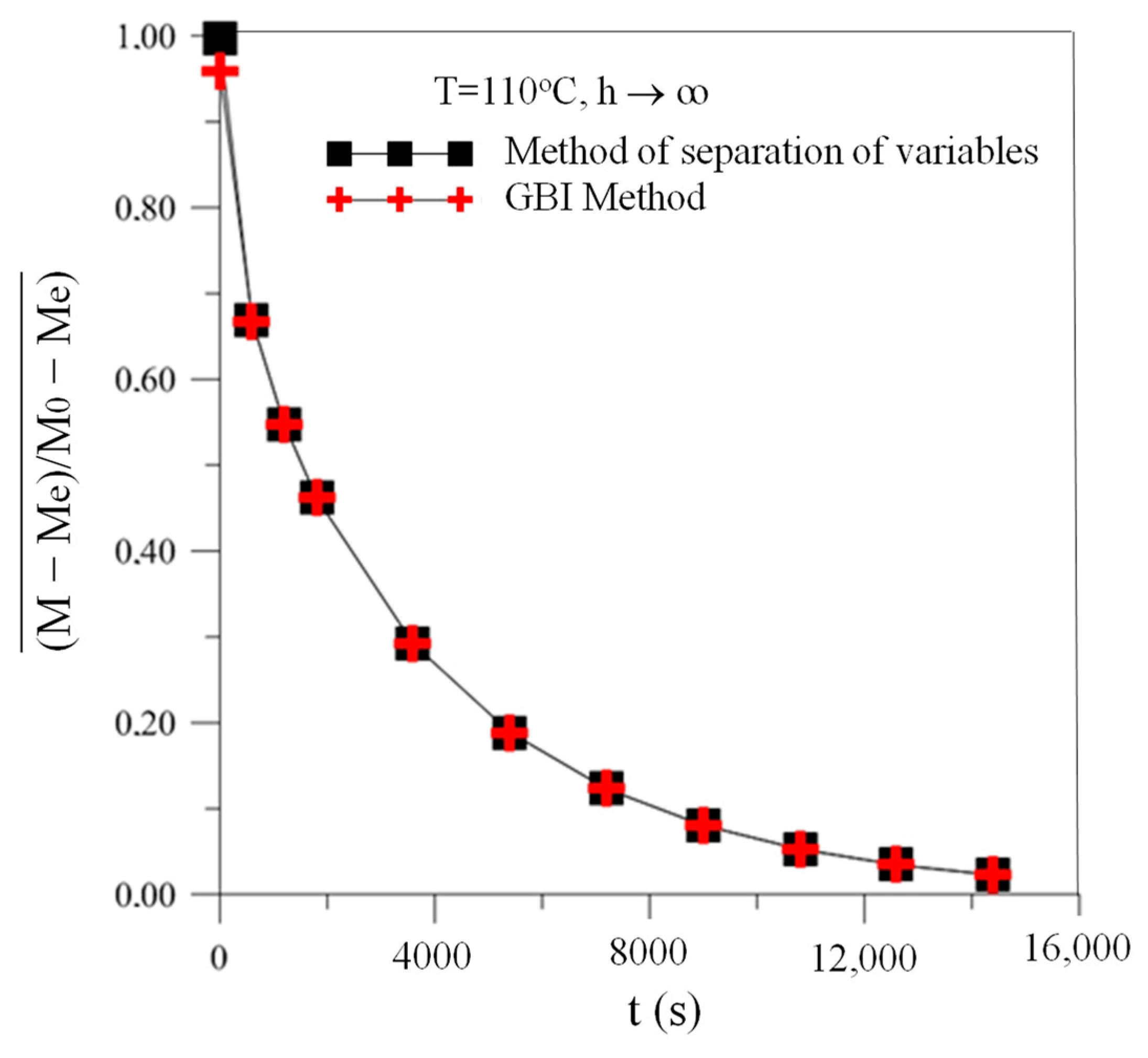
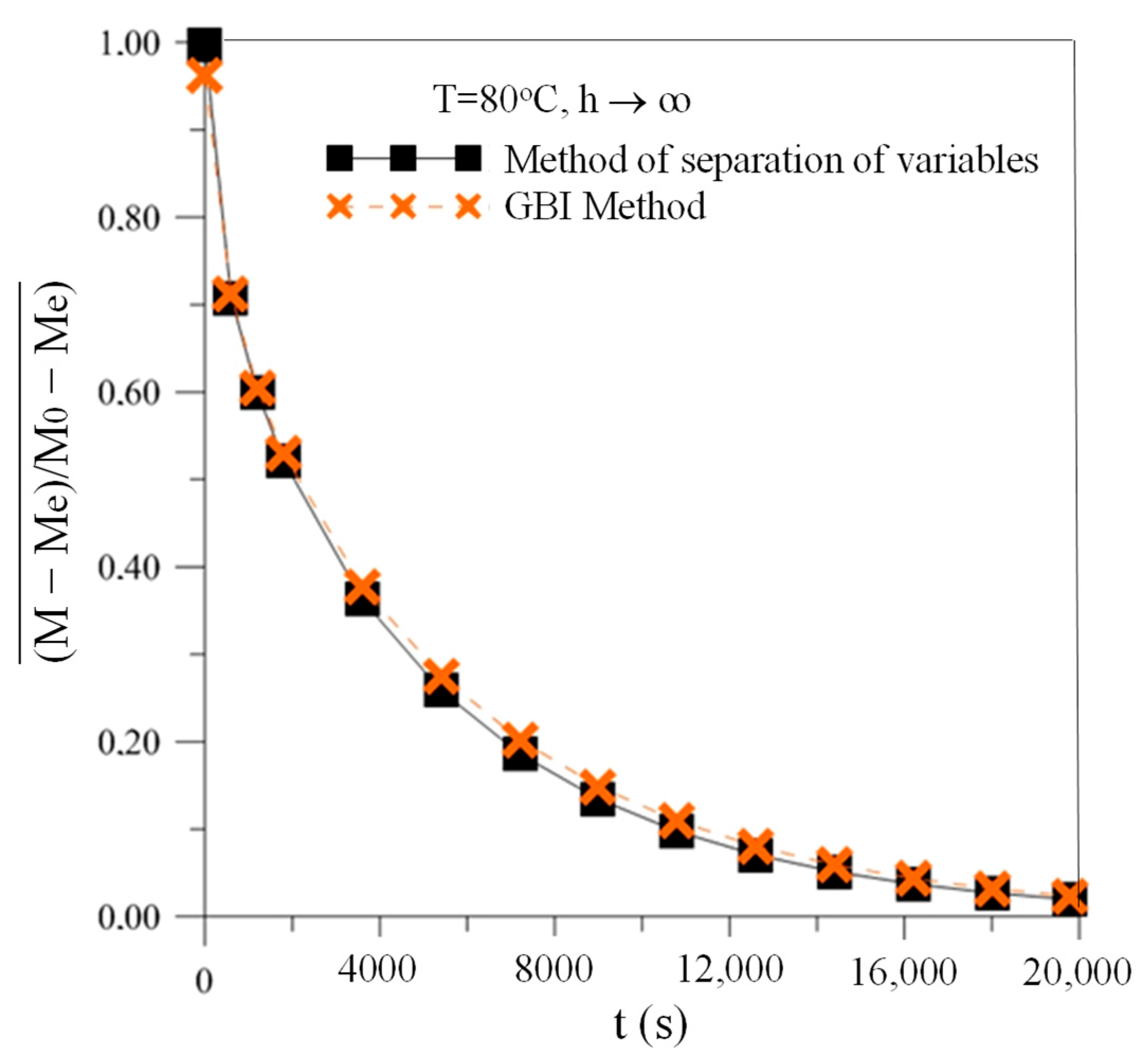
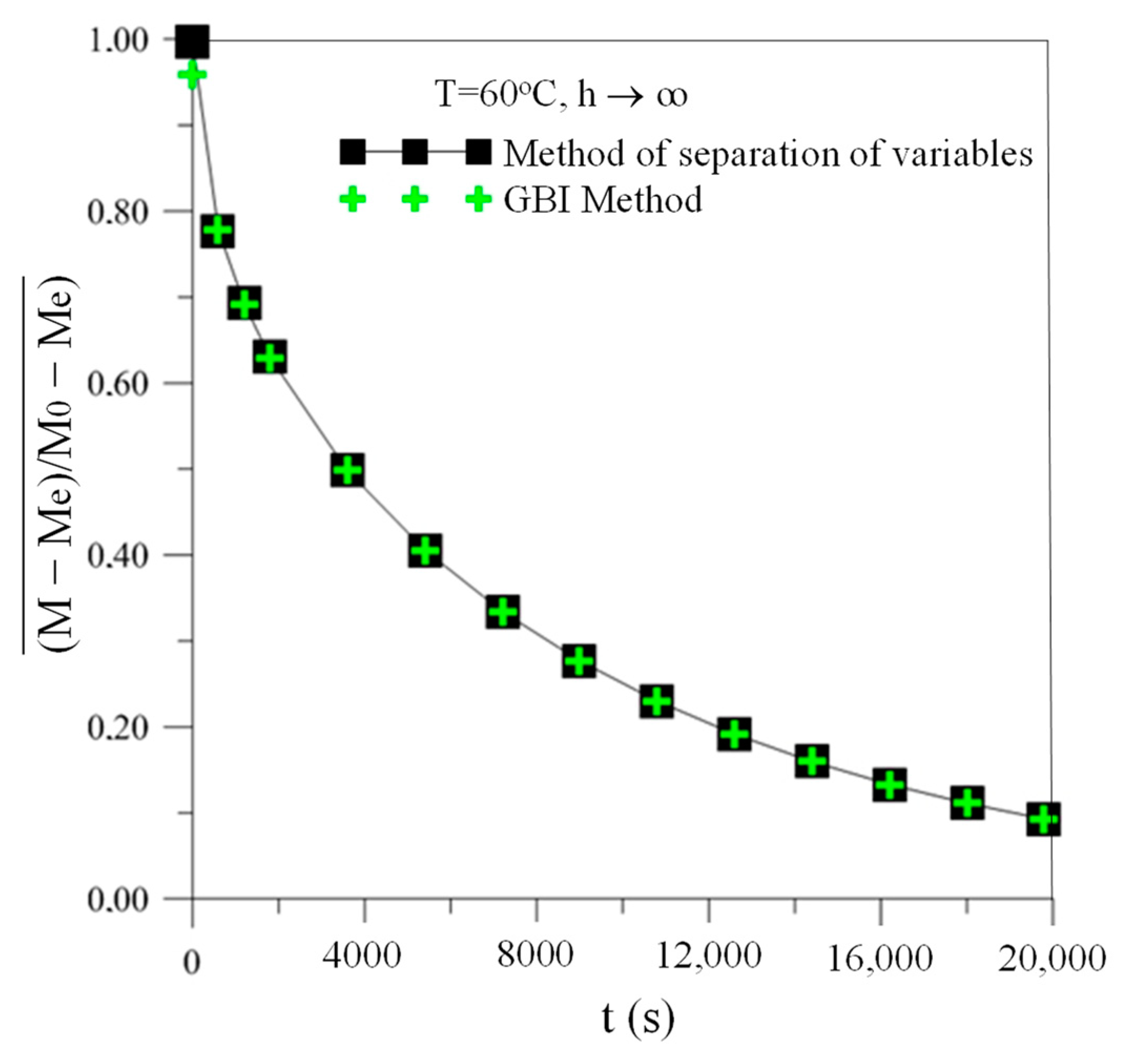
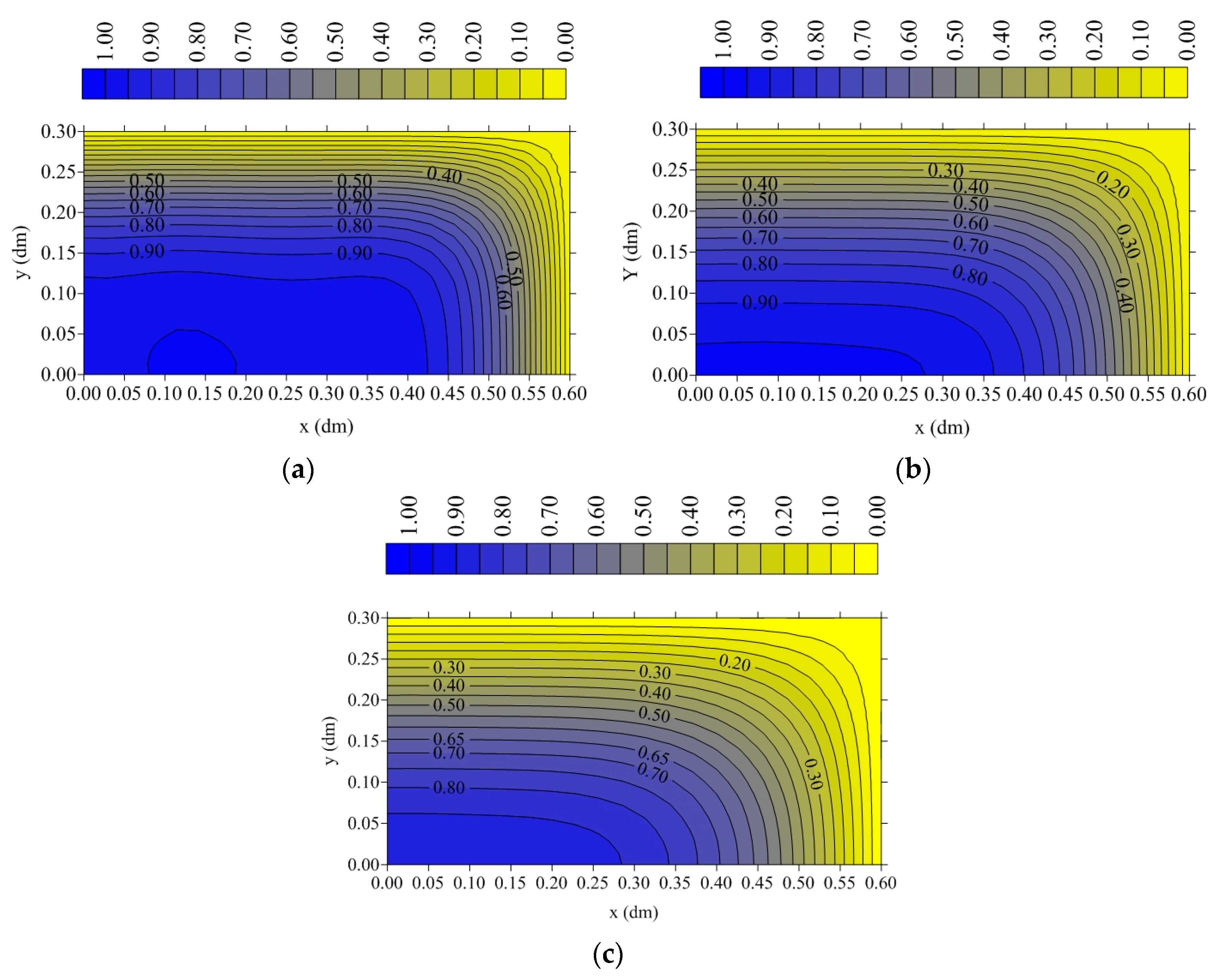
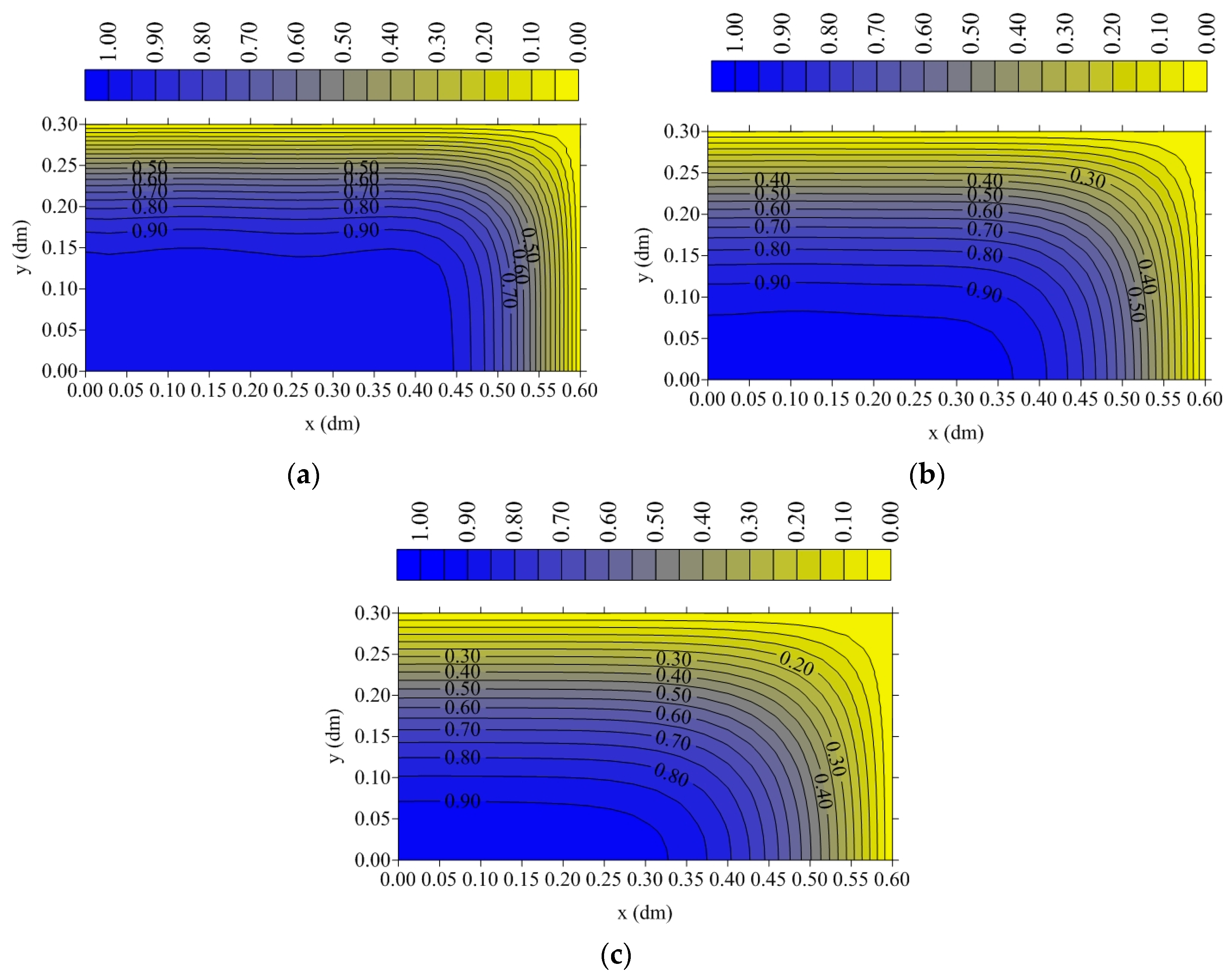
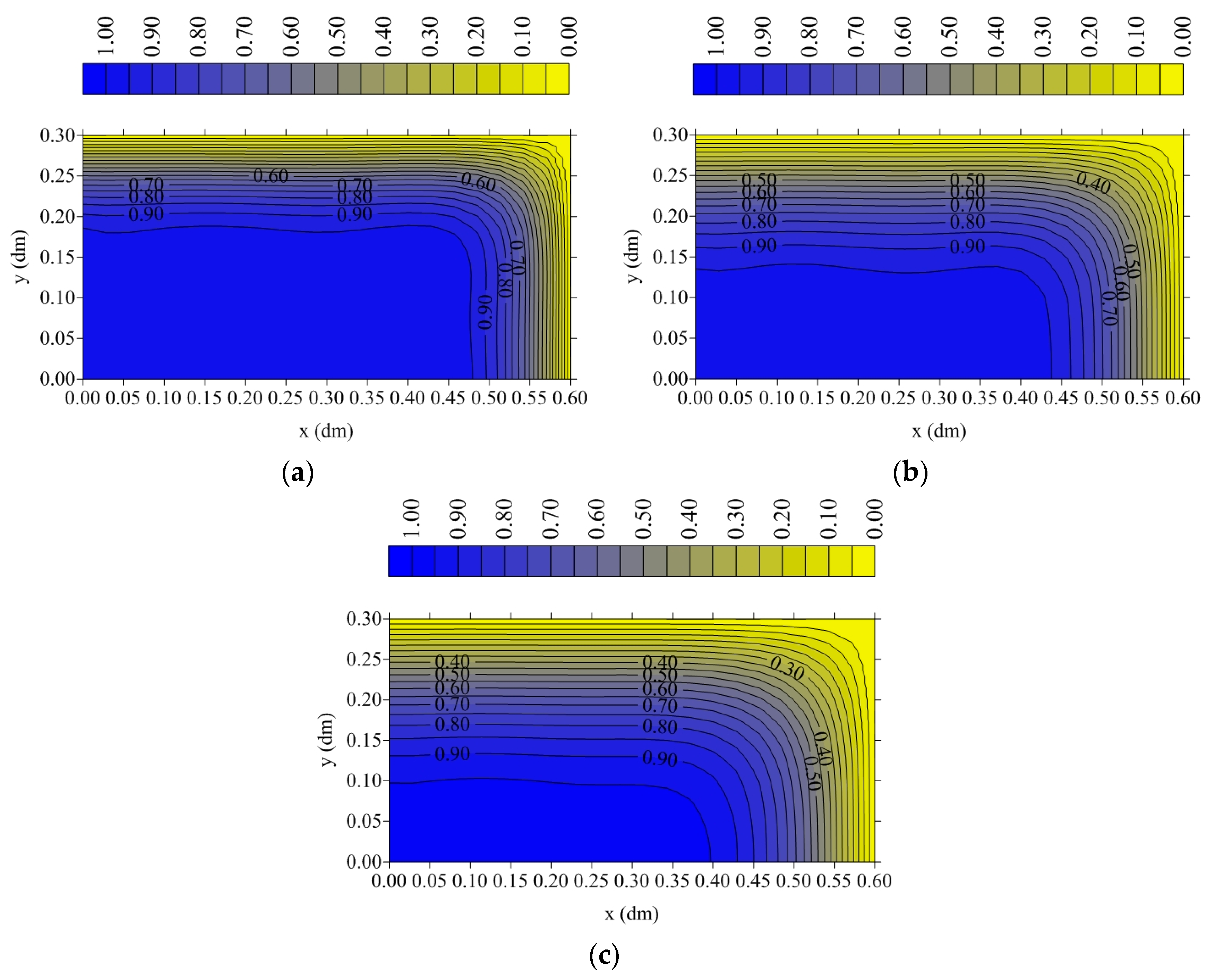
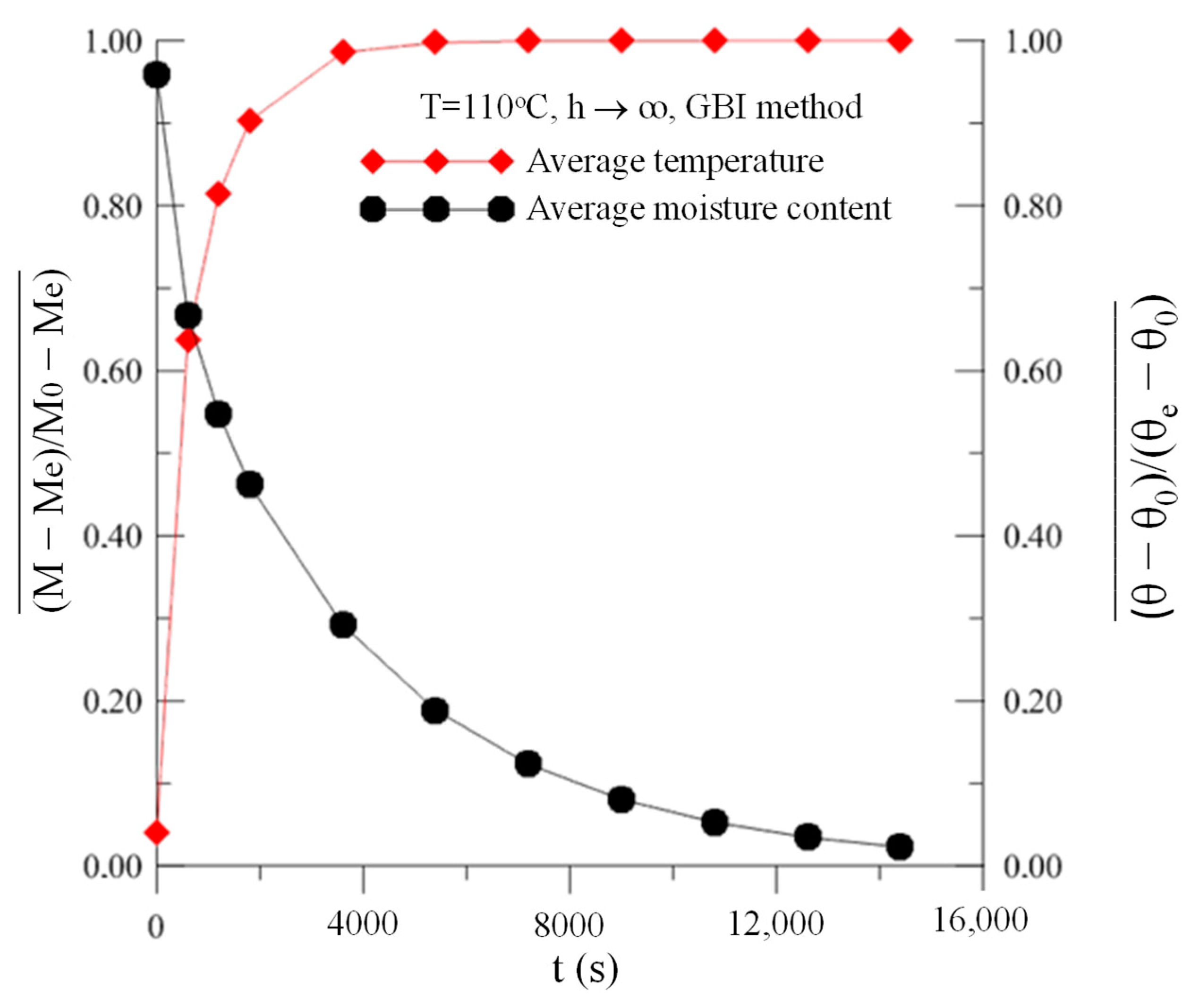
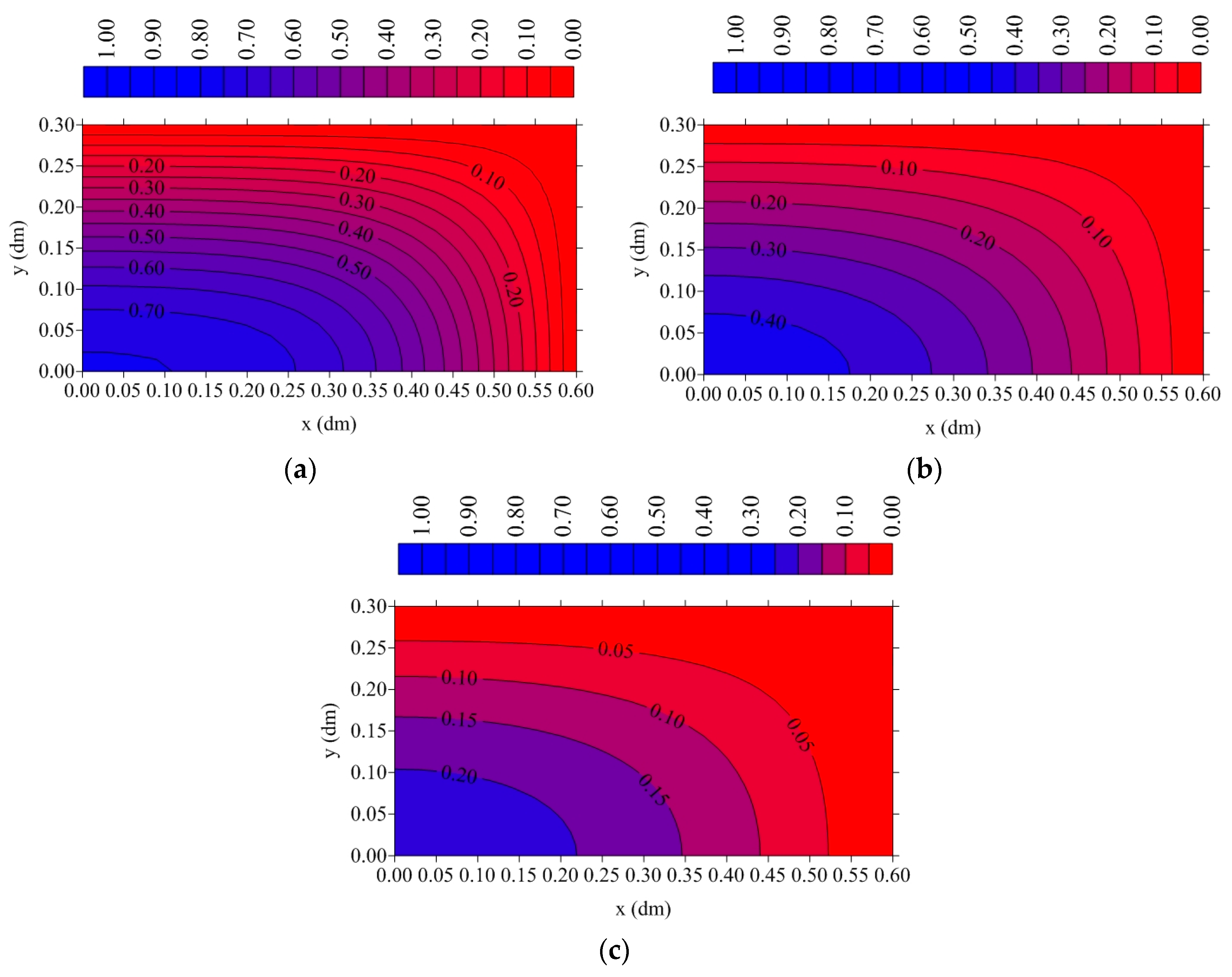
| Air | Ceramic Plate | ||||
|---|---|---|---|---|---|
| T (°C) | RH (%) | R1 (mm) | R2 (mm) | M0 (d.b.) | Me (d.b.) |
| 110 | 2 | 120 | 60 | 0.102 | 0.0043130 |
| 80 | 6 | 120 | 60 | 0.094 | 0.000935 |
| 60 | 14 | 120 | 60 | 0.078 | 0.005395 |
| Air | Ceramic Plate | |||||
|---|---|---|---|---|---|---|
| T (°C) | RH (%) | D (m2/s) | α (m2/s) | (kg/m3) | k (W/m K) | cp (J/kg K) |
| 110 | 2 | 6.82 × 10−8 | 3.11 × 10−7 | 1920 | 1.0 | 1673.51 |
| 80 | 6 | 5.17 × 10−8 | --- | --- | --- | --- |
| 60 | 14 | 2.89 × 10−8 | --- | --- | --- | --- |
Disclaimer/Publisher’s Note: The statements, opinions and data contained in all publications are solely those of the individual author(s) and contributor(s) and not of MDPI and/or the editor(s). MDPI and/or the editor(s) disclaim responsibility for any injury to people or property resulting from any ideas, methods, instructions or products referred to in the content. |
© 2024 by the authors. Licensee MDPI, Basel, Switzerland. This article is an open access article distributed under the terms and conditions of the Creative Commons Attribution (CC BY) license (https://creativecommons.org/licenses/by/4.0/).
Share and Cite
Santos, I.B.; Delgado, J.M.P.Q.; Luiz, M.R.; Gomez, R.S.; Lima, A.G.B.; Pinheiro, L.S.S.; Silva, E.J.C.; Santos, L.E.A.; Brito, G.R.F.; Lima, W.C.P.B.; et al. Drying of a Clayey Ceramic Flat Plate: Simulation Studies Using the Galerkin-Based Integral Method. Buildings 2024, 14, 2674. https://doi.org/10.3390/buildings14092674
Santos IB, Delgado JMPQ, Luiz MR, Gomez RS, Lima AGB, Pinheiro LSS, Silva EJC, Santos LEA, Brito GRF, Lima WCPB, et al. Drying of a Clayey Ceramic Flat Plate: Simulation Studies Using the Galerkin-Based Integral Method. Buildings. 2024; 14(9):2674. https://doi.org/10.3390/buildings14092674
Chicago/Turabian StyleSantos, Ivonete B., João M. P. Q. Delgado, Márcia R. Luiz, Ricardo S. Gomez, Antonio G. B. Lima, Larissa S. S. Pinheiro, Elaine J. C. Silva, Luis E. A. Santos, Glauco R. F. Brito, Wagner C. P. B. Lima, and et al. 2024. "Drying of a Clayey Ceramic Flat Plate: Simulation Studies Using the Galerkin-Based Integral Method" Buildings 14, no. 9: 2674. https://doi.org/10.3390/buildings14092674
APA StyleSantos, I. B., Delgado, J. M. P. Q., Luiz, M. R., Gomez, R. S., Lima, A. G. B., Pinheiro, L. S. S., Silva, E. J. C., Santos, L. E. A., Brito, G. R. F., Lima, W. C. P. B., & Rafael, N. L. T. (2024). Drying of a Clayey Ceramic Flat Plate: Simulation Studies Using the Galerkin-Based Integral Method. Buildings, 14(9), 2674. https://doi.org/10.3390/buildings14092674







